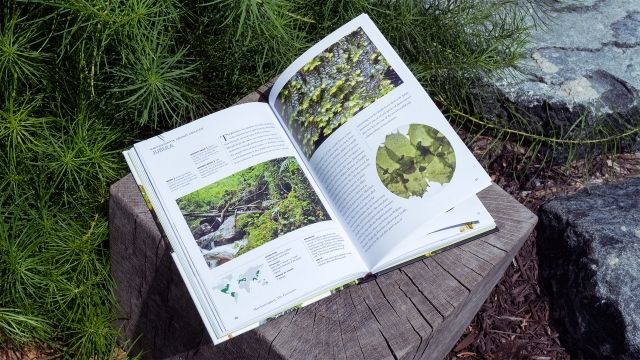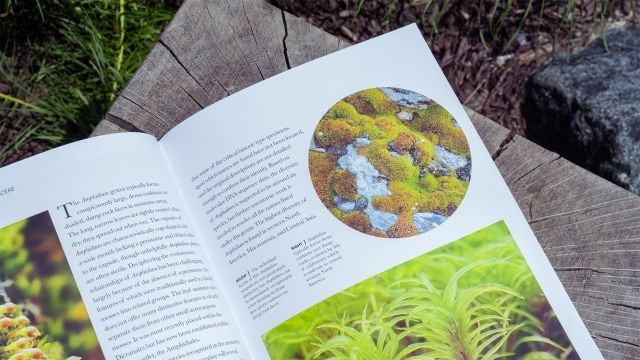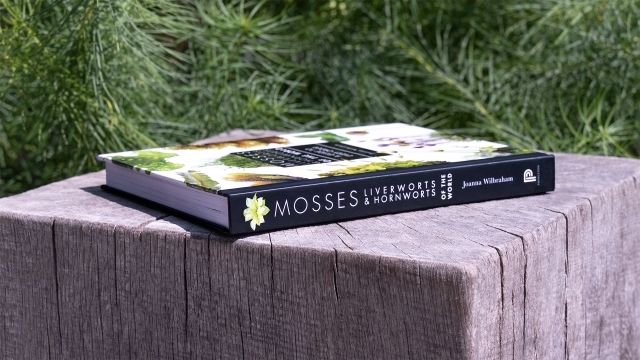This is awesome! Good luck.
17.10.2025 10:44 — 👍 1 🔁 0 💬 0 📌 0
I can't stand seeing those Cladonia mummies. Another frustrating one is the harvesting of large patches of Leucobryum for terraria etc. Really damaging to populations.
06.10.2025 09:45 — 👍 1 🔁 0 💬 0 📌 0
Sounds like an exciting find!
01.10.2025 07:39 — 👍 2 🔁 0 💬 0 📌 0
They do look like hamster ears.
25.09.2025 10:31 — 👍 3 🔁 0 💬 0 📌 0
Nice. This one was full of them. I couldn't find any normal tubers...
24.09.2025 18:23 — 👍 0 🔁 0 💬 0 📌 0
@bbsbryology.bsky.social do you also see these sometimes on tuber-bearing Bryaceae?
24.09.2025 08:57 — 👍 0 🔁 0 💬 1 📌 0

Micrograph of liverwort cells, some of which are infected with brown fungal hyphae while others are healthy and contain plastids and oil bodies.
A final micrograph for today showing mycelium of an Epibryon sp. fungus inside liverwort cells. Most cells are infected but some in the lower part of the photo are healthy, as evidenced by the absence of hyphae and the presence of oil bodies.
23.09.2025 11:50 — 👍 40 🔁 5 💬 1 📌 0
Definitely. They are very difficult to study using classical morphological methods, and getting DNA sequences and/or cultures would probably also be quite tricky.
23.09.2025 11:43 — 👍 2 🔁 0 💬 0 📌 0

A rhizoidal gall on Bryum sp. from mud in a reservoir draw-down zone. It is club-shaped and curved, containing five chytrid zoosporangia inside it, which are spherical. Some of the zoosporangia have thread-like exit tubes leading to the outside, which liberate zoospores that infect other cells.
Micrograph of a rhizoid gall caused by a chytrid on Bryum moss. The infected cell contains several zoosporangia, some of which have thread-like exit tubes that release flagellated spores. Chytrids are interesting fungi that mostly lack hyphae and have mobile spores.
23.09.2025 11:22 — 👍 28 🔁 1 💬 2 📌 0

B. scapaniae is closely related to B. gymnomitrii on Gymnomitrium species. Both fungi grow on the lower parts of host shoots. The larger ascomata of the latter make it slightly easier to spot. Both fungi are very rarely recorded.
23.09.2025 10:26 — 👍 7 🔁 0 💬 0 📌 0

A single shoot of Scapania undulata photographed against a white background. The apex is green while the brown lower parts display infection (arrowed). Bryobroma scapaniae presents as clustered black ascomata and infected tissues are covered by a dense, dark brown mycelium network.

Zoomed in on some infected leaves with dark brown, branching mycelium and black fruitbodies.

Clusters of black fruitbodies on largely leafless basal part of the plant shoot.
Great to find the fungus Bryobroma scapaniae on Scapania undulata in Bannau Brycheiniog in Wales a few days ago. I think this is the third ever record of the species, and I see how it is very easy to miss, with the dark fruitbodies disguised against the black host stem. From a rock in a stream.
23.09.2025 10:16 — 👍 15 🔁 1 💬 1 📌 0
Definitely seen similar drops before. Not sure if that fungus specifically, but it happens.
16.09.2025 10:32 — 👍 1 🔁 0 💬 0 📌 0
Hydnellum peckii can look like this, perhaps it is a place to start. Some mushrooms exude these syrup-like droplets.
16.09.2025 10:24 — 👍 1 🔁 0 💬 0 📌 0
Cheers David!
05.09.2025 15:48 — 👍 1 🔁 0 💬 0 📌 0
Thanks, Jill! It was an unexpected honour and it has been amazing to see how my cohort has grown and developed over the years. Now, for the final push! @gpsep.bsky.social
05.09.2025 14:52 — 👍 9 🔁 0 💬 0 📌 0
* yellow superficial antheridia. I think those in Riccia etc. are immersed but not sure about that.
31.08.2025 11:21 — 👍 0 🔁 0 💬 0 📌 0
Seems reasonable. I don't know it very well, but it is a spready species. The yellow antheridia seem to rule out other genera to me. It does look very strange in general, though! Good luck and hopefully sporophytes won't be needed for it!
31.08.2025 11:18 — 👍 2 🔁 0 💬 1 📌 0
Seems like a Fossombronia of some kind but not sure which.
30.08.2025 16:48 — 👍 3 🔁 0 💬 0 📌 0
Yeah, I was on one about a month ago and it was dreadful.
27.08.2025 18:40 — 👍 1 🔁 0 💬 1 📌 0
That looks good for it, to me.
16.08.2025 12:56 — 👍 1 🔁 0 💬 0 📌 0

The book, "The Structure and Life of Bryophytes" by E. V. Watson. It has a green and white cover with line drawings of bryophytes on it.
Using one of my favourite bryophyte books to help with my thesis. It is a difficult read, densely packed with all kinds of interesting and almost forgotten information. I must have read it half a dozen times, and each time, I notice something profound that I either missed or didn't understand before
13.08.2025 14:55 — 👍 36 🔁 5 💬 1 📌 0
"PhD-level experts in your back pocket" is a completely nonsensical description of AI but a pretty good description of social media if you follow the right people
09.08.2025 23:07 — 👍 10472 🔁 2022 💬 137 📌 171
Nive! A vivid species.
08.08.2025 15:58 — 👍 1 🔁 0 💬 0 📌 0
Very nice Polytrichum strictum too.
08.08.2025 14:01 — 👍 1 🔁 0 💬 0 📌 0
I totally agree. I received it yesterday, and I think it strikes a great balance between being interesting to anyone and useful for specialists. A higher taxon approach really makes you see the diversity and disparity of the three groups. Congrats again @jowilbraham.bsky.social
08.08.2025 10:49 — 👍 1 🔁 0 💬 2 📌 0
In the UK, we bracket species that have not been recorded for 50 years. So, they're included in lists but in parenthesis. Bracketing does not necessarily mean something is locally extinct so a follow-up survey at the previously known sites could justify stretching it to that as you say.
07.08.2025 17:36 — 👍 1 🔁 0 💬 1 📌 0
Any Physcomitrium there too?
06.08.2025 09:20 — 👍 0 🔁 0 💬 0 📌 0
Sainsbury Laboratory Cambridge University (SLCU) is a research institute of the University of Cambridge dedicated to plant developmental biology.
Artist | War-ravaged Portland. Painter, forager, photo industry freelancer, & creative.
Obsessed with fungi, & noticing the little things that make life wonderful. Texture & details make me happy!
🛒🛍️ https://swordfernstudios.etsy.com
Wildlife Manager / Surveyor , Conservationist for Freedom Group and Dalkia .
Country columnist in local newspapers for many years.
Author of Practical Pest Control.
Owner of Hogg Estate Services for many years
Botanist, bryologist and ecologist from SE Ulster. Tá Gaedhlig agam.
Advocate of all things temperate rainforest, hoverflies and placenames
newrywildlife.com
Invertebrate palaeontologist and bryozoologist at the Natural History Museum, London.
Research team focused on Orthotrichaceae (Bryophyta)
Curator of Herpetology & Associate Professor of Vertebrate Zoology at Natural History Museum of Denmark • ERC StG: GEMINI • Co-host of SquaMates Podcast and AnatomyInsights on Youtube • He/Him
Postdoc in the Burlacot lab at Carnegie Science
Stanford Energy Postdoctoral Fellow
Interested in all things photosynthetic 🧪💚
Streptocarpus and regeneration.
NSF PRFB Fellow - Plant Genome Research Program
Duke University
Opinions are my own and do not reflect my funders or institution
Scientist, specializing in bumblebees. Author of various books about insects. Trying to save the planet one bee at a time.
NSF Postdoc Fellow with U of Michigan | PhD from UF I polyploidy evolution + Botany | https://mlgaynor.com/
Institute of Evolutionary Biology @BiolUW @UniWarszawski. From molecules to bones, we are committed to the study of evolution, phylogenetics, and taxonomy.
Research Fellow at @biology.ox.ac.uk interested in the evolution of plants and algae
Grad student working on plant development and evolution. Here to slowly transition my social media.
🍉
The future of plant science relies on future plant scientists! Raising the profile of #plantscience across the UK & beyond. Funded by the Gatsby Charitable Foundation. Jointly based at Botanic Garden and Sainsbury Laboratory, University of Cambridge.
Lifelong Brit birder now retired and living in the Orb Valley, Hérault, France.
One of the finest collections of natural history literature, art and online resources.
Come and research with us Tuesday - Thursday 10.00 - 16.00 (by appointment).
linktr.ee/nhmlibraryarchives
(Natural History Museum, London and Tring)
Postdoc in #LeiboffLab at OSU 🇺🇸 studying maize leaf veins | Fascinated by Plant anatomy ➕Plant development
I seem to be eating memories.
Delving into the realms of plant and fungal biology, from genetic and molecular intricacies to agriculture and ecosystems.


















